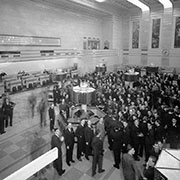CANADA HISTORY
1929 Crash

The Roaring Twenties was a decade marked by economic prosperity, technological advancement, and cultural transformation. In Canada and the United States, the stock market became a symbol of this growth, attracting not just the wealthy but people from all walks of life. The period saw widespread speculation in stocks, with many individuals investing heavily in the market, often through risky financial practices such as buying on margin. This allowed investors to put down as little as 10% of a stock's price and borrow the rest from brokers, with the expectation that the stock’s price would continue to rise. However, as long as brokers did not issue margin calls—requests for repayment of the borrowed funds—investors could defer payment. This practice, combined with a general sense of euphoria in the market, created a speculative bubble that was ripe for collapse.
Throughout the 1920s, the stock market in both the United States and Canada soared to unprecedented heights. Many Canadians mortgaged their homes and emptied their savings to invest, encouraged by stories of rapid, easy profits. Stocks like Imperial Oil and British American Oil reached record highs, and the Toronto Stock Exchange became a hub of frenzied trading activity. As the market continued to climb, more people were drawn into the speculation, believing that the profits would continue indefinitely.
However, by late 1929, signs of trouble began to appear. In September, a wave of selling hit the market, followed by erratic trading as investors grew anxious. Although brief rallies gave the impression that the market would recover, the underlying instability remained. On October 4, 1929, a major sell-off hit Bay Street in Toronto and Wall Street in New York, with the Toronto Stock Exchange suffering losses of approximately $200 million. While a subsequent rally temporarily restored investor confidence, by mid-October, panic had begun to set in.
The market crash culminated in Black Thursday on October 24, 1929, when stock prices began to plummet. As stock prices tumbled, brokers began issuing margin calls, but many investors were unable to meet their obligations, leading to a cascade of selling. The panic grew as brokers rushed to sell stocks to protect themselves from further losses, sending the market into freefall. On that day alone, Montreal’s stock exchange saw a dramatic increase in activity, with over 400,000 shares traded, far surpassing the usual 25,000. Meanwhile, New York saw the trading of over 13 million shares, overwhelming the system to the point where ticker tapes fell hours behind, and chaos overtook the trading floors.
Despite attempts by bankers, brokers, and politicians to reassure the public that the economy's fundamentals remained sound, panic selling resumed on Monday, October 28, when Toronto’s stock market lost one million dollars per minute during the trading session. The crash reached its lowest point on October 29, known as Black Tuesday, when the markets collapsed entirely. Stocks were sold at any price as fear gripped the public, erasing the gains of the previous decade in a matter of hours. Blue-chip stocks in Canada were particularly hard hit, with companies like Brazilian Traction, BA Oil, and Cockshutt Plow suffering devastating losses. By the end of the crash, the Canadian stock market had lost over $5 billion in value, an unprecedented financial catastrophe.
The market crash of 1929 had profound implications for Canada. Investors from all sectors of society were hit hard. Future Canadian Prime Minister Louis St. Laurent was among those devastated, losing his investments and paying off debts incurred from the crash well into the Second World War. Likewise, R.B. Bennett, who would later become Prime Minister, saw a significant portion of his wealth disappear, though his substantial fortune allowed him to absorb the loss more easily.
The collapse of the stock market in 1929 was only the beginning of the greater economic catastrophe that would follow—the Great Depression. As stock values evaporated, consumer confidence plummeted, and the global economy entered a prolonged recession. By 1932/33, the economic depression reached its lowest point, with unemployment soaring and many Canadians struggling to make ends meet. The Canadian economy, heavily reliant on exports and natural resources, saw demand for products such as wheat and timber evaporate, further exacerbating the downturn.
The financial system was left in ruins, with banks collapsing and credit drying up. Poverty and unemployment swept across the country, particularly in rural areas where farmers were already struggling with declining crop prices. The economic recovery would not begin in earnest until the mid-1930s, and it would take the outbreak of World War II in 1939 to fully revive Canada's economy.
In retrospect, the Stock Market Crash of 1929 was a defining moment not only in Canadian history but in the global economic landscape. It shattered the optimism of the Roaring Twenties and exposed the weaknesses in an economy built on speculation and overconfidence. For Canada, the crash highlighted the country's vulnerabilities to global market forces and underscored the importance of fiscal responsibility and economic diversification. It also had a lasting impact on Canadian politics, as governments struggled to respond to the economic crisis and its devastating effects on the population.
The Great Depression that followed the crash fundamentally reshaped Canada's political and economic landscape. It led to the development of social safety nets and government intervention in the economy, changes that would define Canadian public policy for decades to come.
Cite Article : www.canadahistory.com/sections/documents




